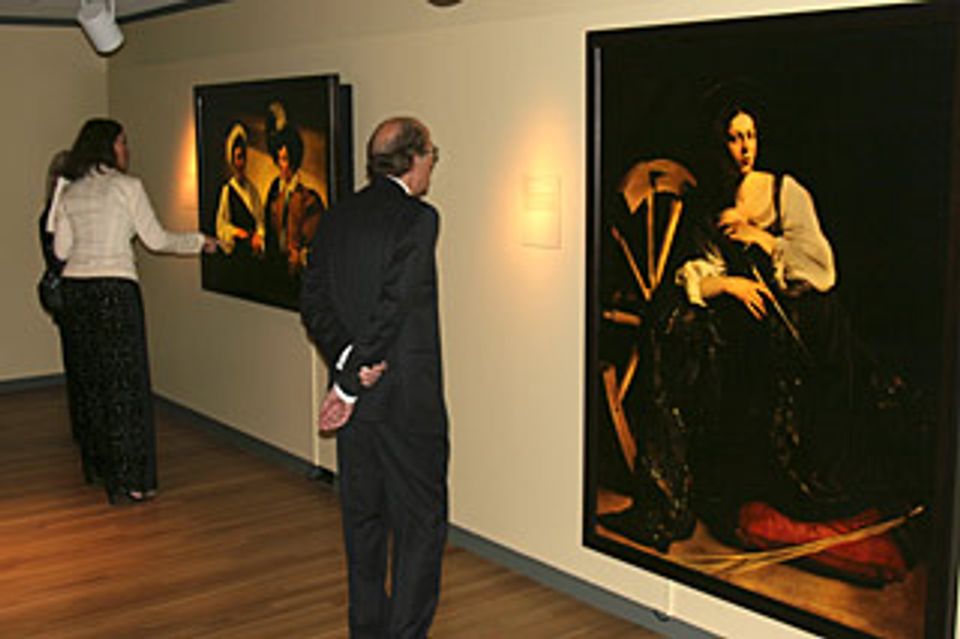
Caravaggio: una mostra impossible Exhibition, Loyola University Museum of Art. Photo by Mark Beane/Loyola University Chicago
There’s a discussion buzzing on the Eye Level backend about Caravaggio: una mostra impossible, the “impossible” Caravaggio exhibit at the Loyola University Museum of Art in Chicago. The exhibit features 57 backlit digital reproductions of works by the artist—masterpieces, all, that surely could never be seen together in any one place at any one time. Some of us are quite critical of this exhibit, while others are ready hitch a ride to Chicago to see the show and buy the T-shirt.
Kriston’s reaction to the idea of a show solely featuring reproductions might fairly be described as a mild epileptic seizure. Chiaroscuro by way of backlighting? Posters standing in for paintings? The exhibit’s creators describe it as an example of the “democratization” of art, but the point he makes is that there is no actual art being democratized!
We all agree that there are educational benefits to a show like this. A religious/educational institution (such as Loyola’s museum) can claim a legitimate interest in emphasizing the narrative and historical aspects of Caravaggio’s work over its formal characteristics, while we can imagine that more conservative institutions (you know who you are!) just wouldn’t go there. And the exhibit’s organizers own up to its unconventional focus up front, likening it to a life-size catalogue and acknowledging that it is no substitute for the originals.
We also agree that in some circumstances copies can be just as good as real things. As a reference point Kriston and Jeff have highlighted Walter Benjamin’s seminal essay, “The Work of Art in the Age of Mechanical Reproduction,” which discusses the way that the advent of mechanical technology (i.e., photography and film) changed the nature of the aesthetic experiences we used to associate only with original things. For example, one doesn’t think of a single film reel as being the “authentic” film; in a similar vein, one doesn’t expect that the aura of a theatrical performance is lost through the mediation of film.
But like the mechanical revolution, we see that the digital revolution only promises to hasten the trend away from the collective, “ritual”-based experience of art—paintings in caves, frescoes in cathedrals—toward venues and processes that are accessible, convenient, and immediate for each individual viewer. St. Louis-based art conservator Phoebe Dent Weil describes the Caravaggio show as a “wonderful second-best thing,” and that drives at the aspect of the show that makes some of us feel uncomfortable. If you consider museums to be the champions of aura and authenticity, then you can’t help but argue that this show displaces both.
Or to sharpen the argument being made: art museums, ultimately, primarily, are repositories of the real thing. No other type of institution plays that role; therefore, even an educational exhibition that provides an unprecedented, exciting, even impossible degree of access will be found lacking by those who look to museums to facilitate the experience of aura and authenticity.
A surprising aspect of our internal debate is that some of our museum professionals—those whom we would expect to be conservative about of the sanctity of Art Museum Traditions—think the Caravaggio exhibition is a perfectly legitimate experiment in exhibition-craft. Perhaps it’s because they get to see the benefit of museum education day-in and day-out, or because they have to struggle with the challenges of actual physical works of art (SAAM traveled 14 exhibitions to 100 stops while the building has been closed for renovation), or because they know how hard it is to turn even great artwork into beautiful and exciting exhibitions. Plus they know that so many museums depend on admission fees and merchandising to fund the thankless (and expensive) tasks of collection stewardship.
Regardless of how we feel about the show’s concept and impact, we’re pretty sure that reproduction Caravaggios won’t do the Loyola University Museum of Art any long-term harm, and it just might open some eyes to the charms of a great master.


















